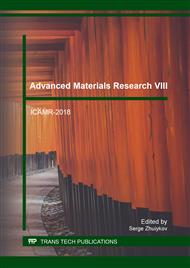p.99
p.106
p.115
p.119
p.124
p.131
p.136
p.140
p.149
Release of Sodium Salicylate from Hydrogels Prepared from Wheat and Arrowroot Starches
Abstract:
Sodium salicylate (SS), a non-steroidal anti-inflammatory drug, was loaded into starch-based hydrogels and the release characteristics of SS therefrom was studied. The hydrogels were prepared from wheat and arrowroot starches and crosslinked with either glutaraldehyde or sodium tetraborate decahydrate (borax). SS was loaded into hydrogel at concentrations of 10 and 20%w/w based on dry weight of sample. The study of release characteristics was carried out by total immersion method for 24 h in an acetate buffer solution (pH 5.5) at 32°C as the same condition of human skin. A burst release of SS at the initial time followed by a gradual release to reach a plateau was observed. The maximum amounts of SS released from the hydrogels were about 8-22 mg. The amount of water retention of hydrogels was also determined at the same condition with that of the study of release. The hydrogels with the greater amount of water retention showed the higher release of SS. The hydrogels crosslinked with borax had higher amounts of SS released than those crosslinked with glutaraldehyde. The hydrogels containing 20% SS-loaded showed higher amounts of SS released than those containing 10% SS-loaded. The hydrogels prepared from arrowroot starch showed higher amounts of SS released than those prepared from wheat starch. From the study of release kinetics based on the Korsmeyer-Peppas model, the exponents of release (n) of all specimens were close to 1 which indicated Case II diffusion.
Info:
Periodical:
Pages:
124-130
Citation:
Online since:
March 2018
Keywords:
Price:
Сopyright:
© 2018 Trans Tech Publications Ltd. All Rights Reserved
Share:
Citation:


